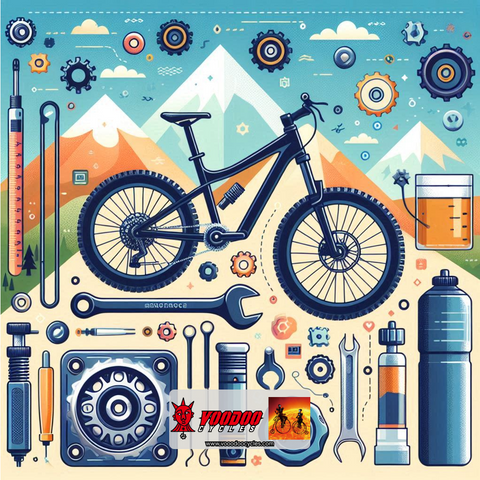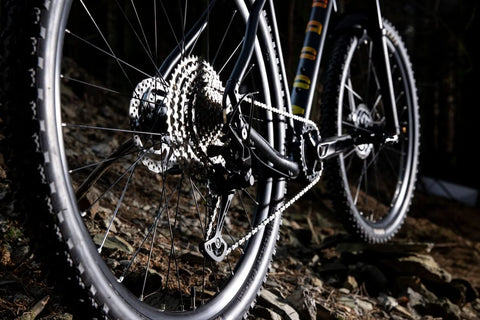
Buying a mountain bike is just the beginning of your investment. Mountain bike maintenance is essential to keep your bike in top condition and to extend its longevity. As mountain bikes become more expensive every day from enhanced attributes, technology, and added features; proper maintenance becomes critical. This article will explore tips including, mountain bike basic maintenance tips, when to service a mountain bike, how to service a mountain bike, brake maintenance tips and more.

Let's start off by explaining some general mountain bike maintenance elements that needs to be done on a regularly.
General Mountain Bike Maintenance
Cleaning & Lubrication
This should be the first and foremost duty of a mountain bike owner to clean their bike daily and before use. Use diluted dish soap or a pre-formulated bike cleaner to clean ensures thorough removal of dust, mud, and debris from key components of the bike. If the dirt and grime is kept attached to the bike, it can lead to wear and tears and also absorb grease and lubricants. Not only will a clean bike shift better, it will also allow faster performance from the reduced friction and more reliable braking. Cleaning the bike regularly also provides opportunities for inspection, allowing the rider to identify and address any wear or damage that may be a safety concern.
Tire Maintenance (Pressure & Wheel Alignment)
Mountain bike owners are advised to keep a reliable gauge to maintain optimal tire pressure. Check for any loosening bolts or misalignment in the wheels by moving the tire sideways while holding the fork. Adjust your tire pressure according to your own needs. Lower pressure increases contact surface area between the tire and the ground improving grip. It can also help with reducing the risk of pinch flats, especially with tubeless tires. On the other hand, higher tire pressure reduces rolling resistance which assists with speed on smoother surfaces. It is important for each rider to experiment with and find their own optimal tire pressure as the optimal tire pressure is highly subjected based on each riders' weight, riding style, terrain type, and tire specifications.
Tightening Bolts and Fasteners
Enhance the durability of your bike by checking the tightening of all bolts and fasteners on vital parts before every ride. Properly tightened bolts and fasteners can help prevent component failure by ensuring components remain securely attached. The failure to tighten loose bolts can cause serious accidents, such as handlebars slipping or brakes failing. Conversely, over-tightening can lead to costly repairs/replacement especially for those made from softer materials like aluminum or carbon fiber by stripping threads or damaging components. Use a torque wrench to guarantee the bolts and fasteners are tightened to the correct specifications.
Mountain Bike Storage
Store the bike indoors or in a sheltered area that it's protected from weather conditions such as humidity, rain, snow, and UV rays; they are known to cause rust and component deterioration over time. fI you want to go a step further, you can use hooks to elevate the bike from the ground in times of storage to give it an added advantage in terms of the safety of the equipment. If the bike must be stored outside, consider a dedicated bike shed or box to provide protection from weather conditions. If a shed or box is not possible, consider a weather-resistant cover to protect against rain and dirt accompanied by a high-quality lock for security.
Mountain Bike Maintenance Schedule
Every Month or 5 to 7 Rides: Basic Check
Check Brake Pads
Fork air pressure
Lubricate the chain
Every 3 to 6 months: Critical Parts
Drivetrain Inspection
The main components of the drive train are the chain, cassette, derailleur pulleys, and chainrings. If they seem worn out, immediately replace them. During this time, also inspect the cables to see if they are functioning properly.
Tires Inspection
Carefully inspect the sidewalls and tubeless tire sealant at regular intervals. If the sealant is found to be low, add more as necessary. Additionally, check for cuts, bulges, and excessive wear on the tires, and replace them if needed.
Hydraulic Brake Fluid Check
For mountain bikes equipped with hydraulic brakes, it is recommended to replace the hydraulic brake oil if it darkens in color within a specific period depending on your usage.
6 Months to 1 Year: Main Parts
Rear Shock Service
If the shock starts making a wheezing or clunking sound after six months to one year of use, it means a full service is necessary. The service of the rear shock is a complex task that is not recommended to be self-done. Taking your mountain bike to a dedicated workshop or your place of purchases to make sure it's done correctly.
Frame Service
After one year the frame may have developed certain cracks, dents, or damage due to the adventurous undertaking of the mountain bike. This will require the frame to be fully dissembled, cleaned, its bearing replaced, other damage welded, then reassembled. Same as rear shock servicing, service by a professional is highly recommend.
Conclusion
Keep in mind that these aren’t hard and fast intervals but rather general guideline recommendations for average riders. The frequency of maintenance varies with the frequency of use of the mountain bike, the kinds of tracks you ride on, and also depends on the climate of the area where you live and go mountain biking.
We have tried to cover everything related to the maintenance of mountain bikes. However, if you’re unsure about any maintenance task, seek assistance from a professional bike shop. Maximize your mountain biking experience and get the most out of your trusted two-wheeled companion by investing time and effort into bike maintenance. Lets ride to Mars together!
Looking for a new companion to accompany you on your next mountain biking adventure?






